Assessing the Suitability of Fractal Dimension for Measuring Graphic Complexity Change in Schematic Metro Networks
Abstract
1. Introduction
- to simplify lines to basic shapes;
- to re-orient lines along grid lines;
- to enlarge congested areas to spread the density of the network.
2. Data and Method
2.1. The Metro Networks of 26 Chinese Cities as the Experimental Data
2.2. Fractal Theory
- The development of fractal theory
- Calculation of fractal dimension
3. Analysis of Complexity Change in Schematization
3.1. Complexity Change in Schematization by Fractal Dimension
3.2. Comparison of Complexity Change between Fractal Dimension and Psychological Questionnaire
3.3. Correlation between the Original Metro Network’s Complexity and the Complexity Change of Subjective Opinions
4. Discussion
5. Conclusions
Supplementary Materials
Author Contributions
Funding
Data Availability Statement
Conflicts of Interest
References
- Lan, T.; Li, Z.L.; Wang, J.C.; Gong, C.Y.; Ti, P. An ANNs-based method for automated labelling of schematic metro maps. ISPRS Int. J. Geo-Inf. 2022, 11, 36. [Google Scholar] [CrossRef]
- Stott, J.; Rodgers, P.; Martínez-Ovando, J.C.; Walker, S.G. Automatic metro map layout using multicriteria optimization. IEEE Trans. Vis. Comput. Graph. 2011, 17, 101–114. [Google Scholar] [CrossRef] [PubMed]
- Nöllenburg, M. A survey on automated metro map layout methods. In Proceedings of the 1st Schematic Mapping Workshop, Essex, UK, 2–3 April 2014. [Google Scholar]
- Hong, S.-H.; Merrick, D.; do Nascimento, H.A. Automatic visualisation of metro maps. J. Vis. Lang. Comput. 2006, 17, 203–224. [Google Scholar] [CrossRef]
- Ti, P.; Wu, H.; Li, Z.L.; Li, M.Y.; Dai, R.Y.; Xiong, T. Revealing schematic map designs with preservation of relativity in node position and segment length in existing official maps. ISPRS Int. J. Geo-Inf. 2023, 12, 309. [Google Scholar] [CrossRef]
- Zheng, M.-C.; Liu, Y.-W. Effect of compositions of MRT system route maps on cognitive mapping. ISPRS Int. J. Geo-Inf. 2021, 10, 569. [Google Scholar] [CrossRef]
- Forrest, D. The top ten maps of the twentieth century: A personal view. Cartogr. J. 2003, 40, 5–15. [Google Scholar] [CrossRef]
- Cartwright, W. Rethinking the definition of the word ‘map’: An evaluation of Beck’s representation of the London Underground through a qualitative expert survey. Int. J. Digit. Earth 2015, 8, 522–537. [Google Scholar] [CrossRef]
- Hahn, W.C.; Weinberg, R.A. A subway map of cancer pathways. Nat. Rev. Cancer 2002, 2, 331–334. [Google Scholar] [CrossRef]
- Elroi, D.S. Designing a network line-map schematization software enhancement package. In Proceedings of the 8th International ESRI User Conference, Redlands, CA, USA, 21–25 March 1988. [Google Scholar]
- Nollenburg, M.; Wolff, A. Drawing and labeling high-quality metro maps by mixed-integer programming. IEEE Trans. Vis. Comput. Graph. 2011, 17, 626–641. [Google Scholar] [CrossRef]
- Mark Ware, J.; Taylor, G.E.; Anand, S.; Thomas, N. Automated production of schematic maps for mobile applications. Trans. GIS 2006, 10, 25–42. [Google Scholar] [CrossRef]
- Lan, T.; Li, Z.L.; Ti, P. Integrating general principles into mixed-integer programming to optimize schematic network maps. Int. J. Geogr. Inf. Sci. 2019, 33, 2305–2333. [Google Scholar] [CrossRef]
- Ware, M.; Richards, N. An Ant Colony System algorithm for automatically schematizing transport network data sets. In Proceedings of the 2013 IEEE Congress on Evolutionary Computation, Cancun, Mexico, 20–23 June 2013; pp. 1892–1900. [Google Scholar]
- Galvao, M.; Ramos, F.; Lamar, M.; Taco, P. Dynamic Visualization of Transit Information Using Genetic Algorithms for Path Schematization; Springer: Cham, Switzerland, 2017; pp. 99–113. [Google Scholar]
- Li, Z.L.; Dong, W.H. A stroke-based method for automated generation of schematic network maps. Int. J. Geogr. Inf. Sci. 2010, 24, 1631–1647. [Google Scholar] [CrossRef]
- Ti, P.; Li, Z.L. Generation of schematic network maps with automated detection and enlargement of congested areas. Int. J. Geogr. Inf. Sci. 2014, 28, 521–540. [Google Scholar] [CrossRef]
- Lan, T.; Li, Z.L.; Peng, Q.; Gong, X.Y. Automated labeling of schematic maps by optimization with knowledge acquired from existing maps. Trans. GIS 2020, 24, 1722–1739. [Google Scholar] [CrossRef]
- Roberts, M.J.; Newton, E.J.; Lagattolla, F.D.; Hughes, S.; Hasler, M.C. Objective versus subjective measures of Paris Metro map usability: Investigating traditional octolinear versus all-curves schematics. Int. J. Hum.-Comput. Stud. 2013, 71, 363–386. [Google Scholar] [CrossRef]
- Roberts, M.J.; Gray, H.; Lesnik, J. Preference versus performance: Investigating the dissociation between objective measures and subjective ratings of usability for schematic metro maps and intuitive theories of design. Int. J. Hum.-Comput. Stud. 2017, 98, 109–128. [Google Scholar] [CrossRef]
- Lloyd, P.B.; Rodgers, P.; Roberts, M.J. Metro map colour-coding: Effect on usability in route tracing. In Proceedings of the Diagrammatic Representation and Inference: 10th International Conference, Diagrams 2018, Proceedings 10, Edinburgh, UK, 18–22 June 2018; pp. 411–428. [Google Scholar]
- Burch, M.; Raschke, M.; Blascheck, T.; Kurzhals, K.; Weiskopf, D. How do people read metro maps? An eye tracking study. In Proceedings of the 1st Workshop on Schematic Mapping, Essex, UK, 2–3 April 2014; pp. 2–3. [Google Scholar]
- Burch, M.; Kurzhals, K.; Weiskopf, D. Visual task solution strategies in public transport maps. In Proceedings of the 2nd International Workshop on Eye Tracking for Spatial Research, Vienna, Austria, 23 September 2014; pp. 32–36. [Google Scholar]
- Liu, Z.; Li, Z.L. Impact of schematic designs on the cognition of underground tube maps. Int. Arch. Photogramm. Remote Sens. Spat. Inf. Sci. 2016, 41, 421–423. [Google Scholar] [CrossRef]
- Netzel, R.; Ohlhausen, B.; Kurzhals, K.; Woods, R.; Burch, M.; Weiskopf, D. User performance and reading strategies for metro maps: An eye tracking study. Spat. Cogn. Comput. 2017, 17, 39–64. [Google Scholar] [CrossRef]
- Goodchild, M.F. Fractals and the accuracy of geographical measures. J. Int. Assoc. Math. Geol. 1980, 12, 85–98. [Google Scholar] [CrossRef]
- Yan Guang, C.; Jing, L. The fractal features of the transport network of Henan Province. J. Xinyang Norm. Univ. (Nat. Sci. Ed.) 1998, 11, 172–177. [Google Scholar]
- Fairbairn, D. Measuring map complexity. Cartogr. J. 2006, 43, 224–238. [Google Scholar] [CrossRef]
- Mohajeri, N.; Longley, P.; Batty, M. City shape and the fractality of street patterns. Quaest. Geogr. 2012, 31, 29–37. [Google Scholar] [CrossRef]
- Lan, T.; Li, Z.L.; Zhang, H. Urban allometric scaling beneath structural fractality of road networks. Ann. Am. Assoc. Geogr. 2019, 109, 943–957. [Google Scholar] [CrossRef]
- Zhang, H.; Gao, P.C.; Lan, T.; Liu, C.L. Exploring the structural fractality of urban road networks by different representations. Prof. Geogr. 2021, 73, 348–362. [Google Scholar] [CrossRef]
- Mandelbrot, B. How long is the coast of Britain? Statistical self-similarity and fractional dimension. Science 1967, 156, 636–638. [Google Scholar] [CrossRef]
- Mandelbrot, B.B. The Fractal Geometry of Nature; WH Freeman: New York, NY, USA, 1982; Volume 1. [Google Scholar]
- Jiang, B.; Yin, J.J. Ht-index for quantifying the fractal or scaling structure of geographic features. Ann. Assoc. Am. Geogr. 2014, 104, 530–540. [Google Scholar] [CrossRef]
- Gao, P.C.; Liu, Z.; Liu, G.; Zhao, H.R.; Xie, X.X. Unified metrics for characterizing the fractal nature of geographic features. Ann. Am. Assoc. Geogr. 2017, 107, 1315–1331. [Google Scholar] [CrossRef]
- Batty, M.; Longley, P.A. The fractal simulation of urban structure. Environ. Plan. A 1986, 18, 1143–1179. [Google Scholar] [CrossRef]
- Mandelbrot, B.B. Stochastic models for the Earth’s relief, the shape and the fractal dimension of the coastlines, and the number-area rule for islands. Proc. Natl. Acad. Sci. USA 1975, 72, 3825–3828. [Google Scholar] [CrossRef]
- Gagnepain, J.; Roques-Carmes, C. Fractal approach to two-dimensional and three-dimensional surface roughness. Wear 1986, 109, 119–126. [Google Scholar] [CrossRef]
- Benguigui, L. A fractal analysis of the public transportation system of Paris. Environ. Plan. A 1995, 27, 1147–1161. [Google Scholar] [CrossRef]
- Lu, Y.M.; Tang, J.M. Fractal dimension of a transportation network and its relationship with urban growth: A study of the Dallas-Fort Worth area. Environ. Plan. B Plan. Des. 2004, 31, 895–911. [Google Scholar] [CrossRef]
- Lan, T.; Peng, Q.; Wang, H.Y.; Gong, X.Y.; Li, J.; Shi, Z.C. Exploring allometric scaling relations between fractal dimensions of metro networks and economic, environmental and social indicators: A case study of 26 cities in China. ISPRS Int. J. Geo-Inf. 2021, 10, 429. [Google Scholar] [CrossRef]
- Prah, K.; Shortridge, A.M. Vertical vs. Horizontal fractal dimensions of roads in relation to relief characteristics. ISPRS Int. J. Geo-Inf. 2023, 12, 487. [Google Scholar] [CrossRef]
- Rosenholtz, R.; Li, Y.Z.; Nakano, L. Measuring visual clutter. J. Vis. 2007, 7, 17. [Google Scholar] [CrossRef]

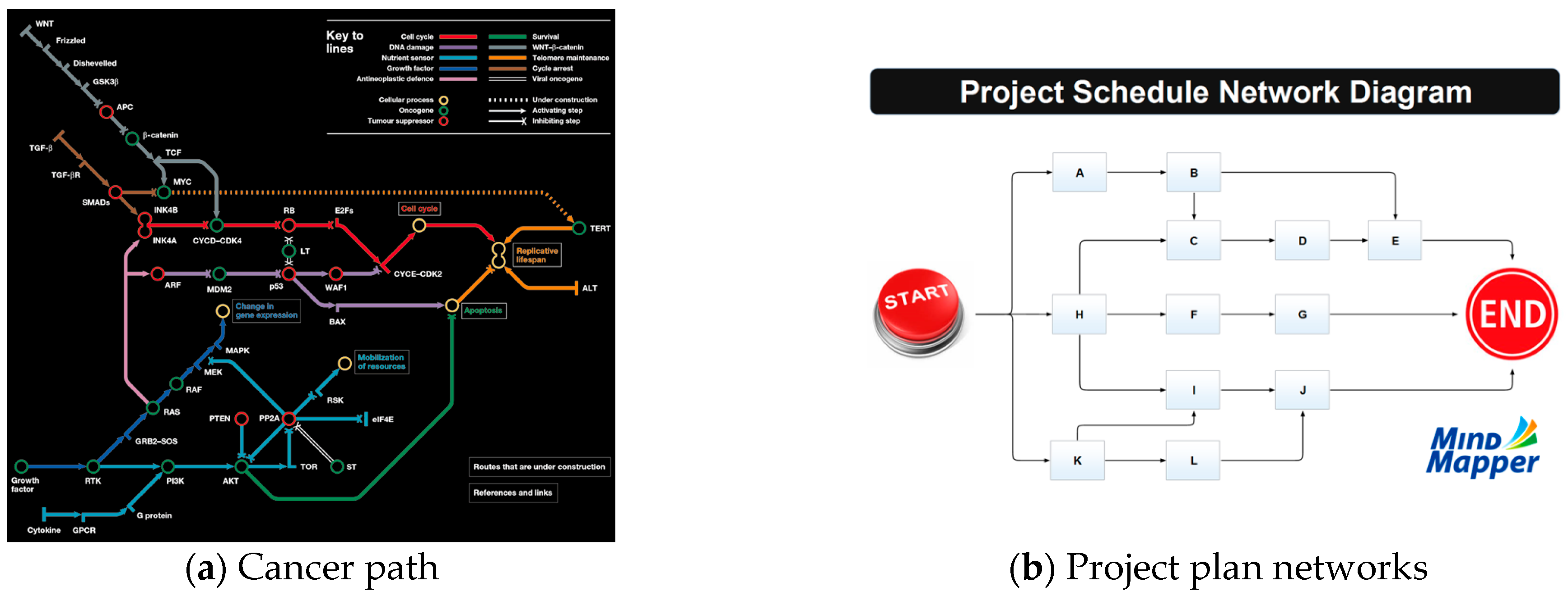

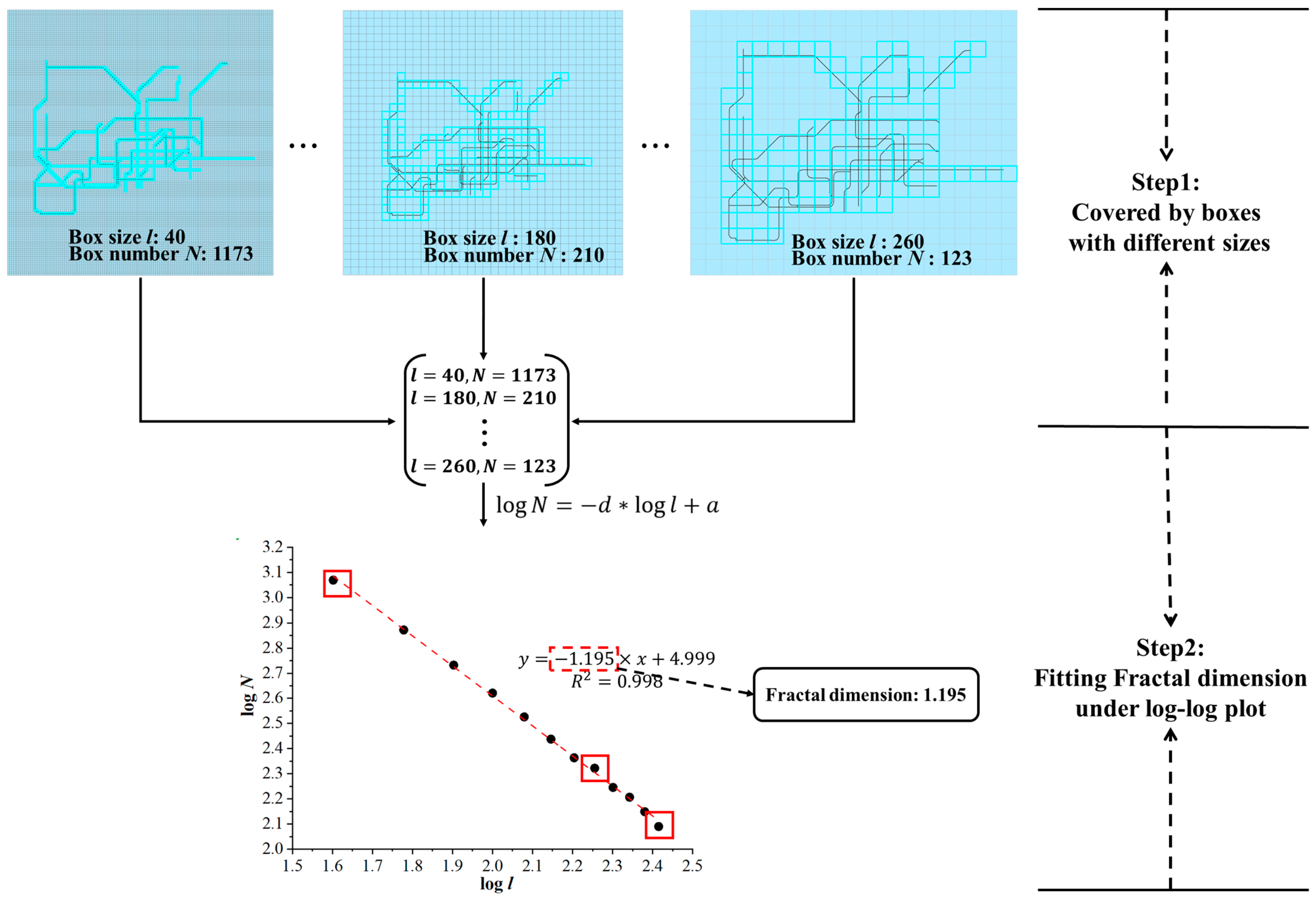
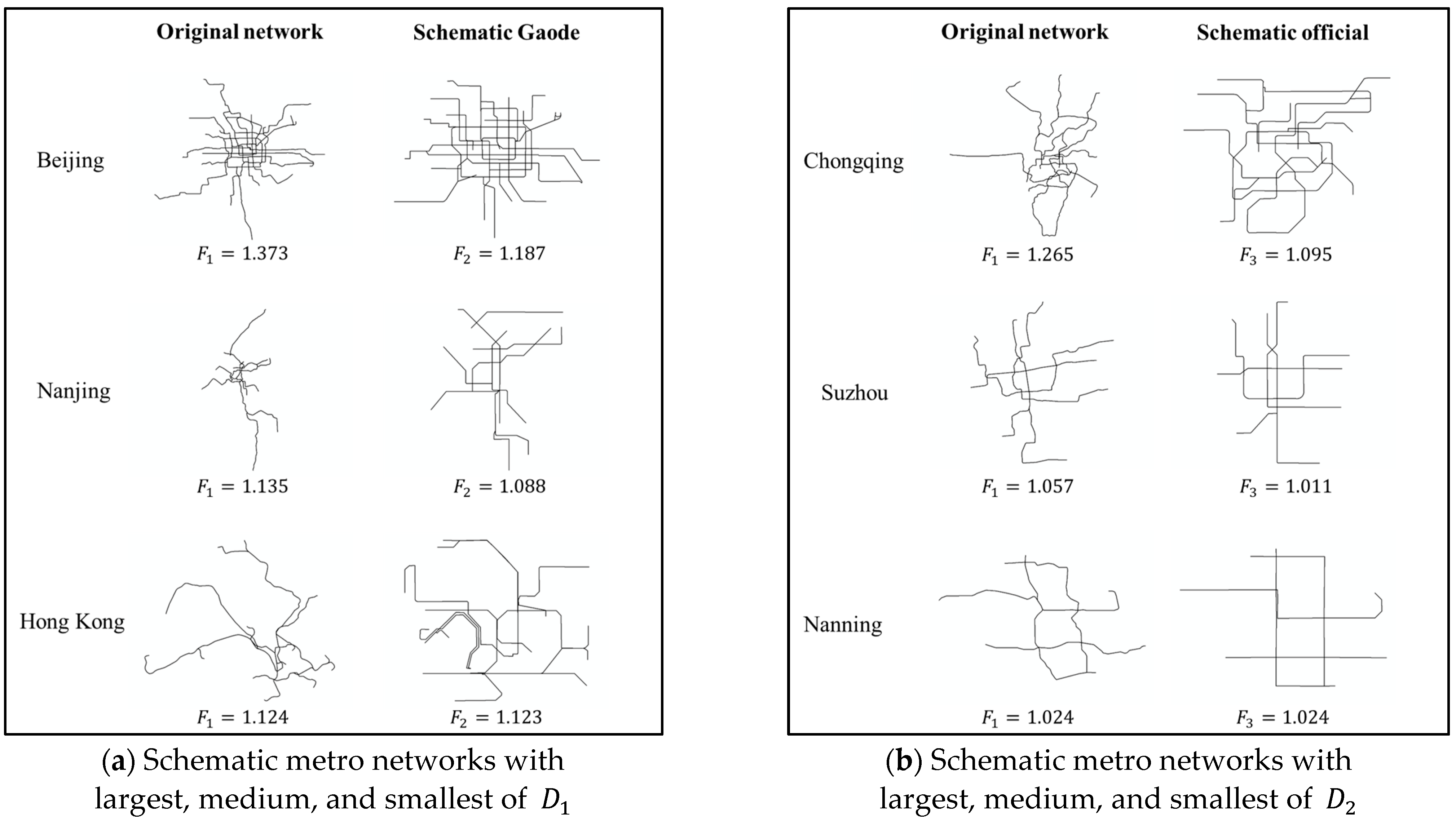
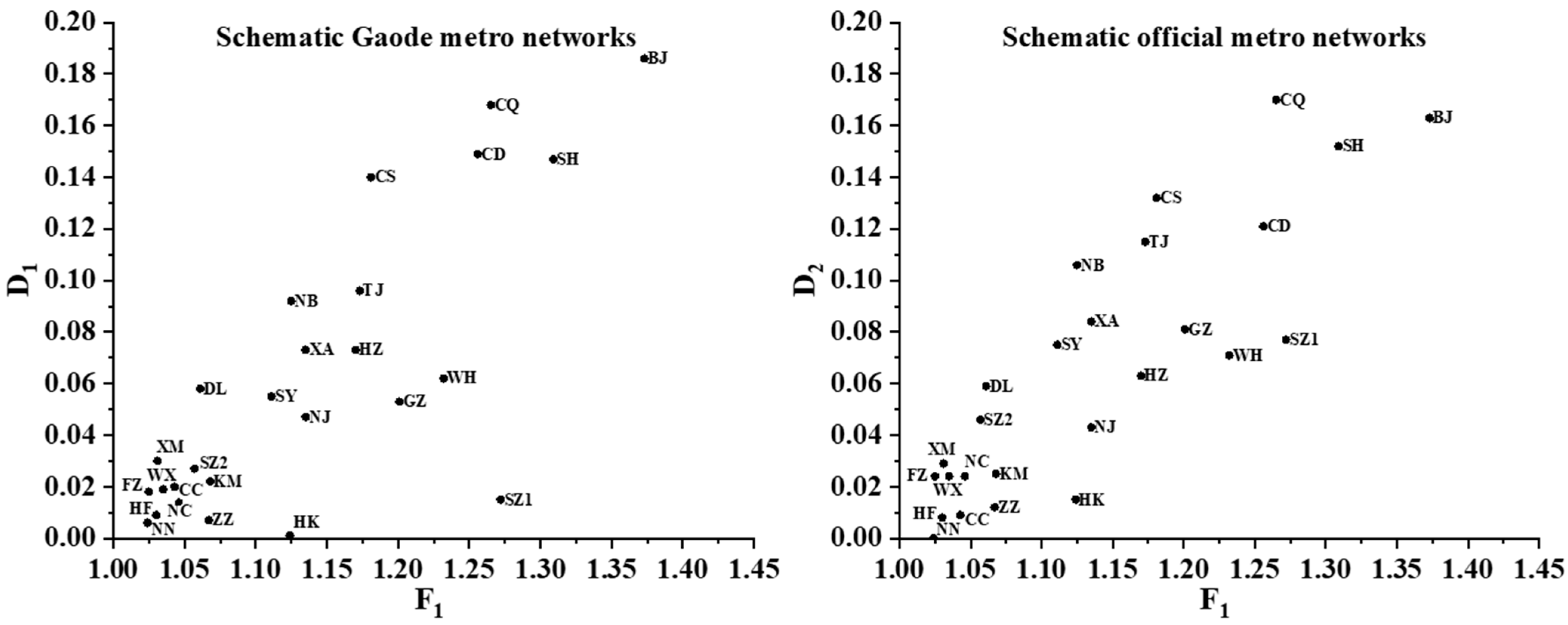

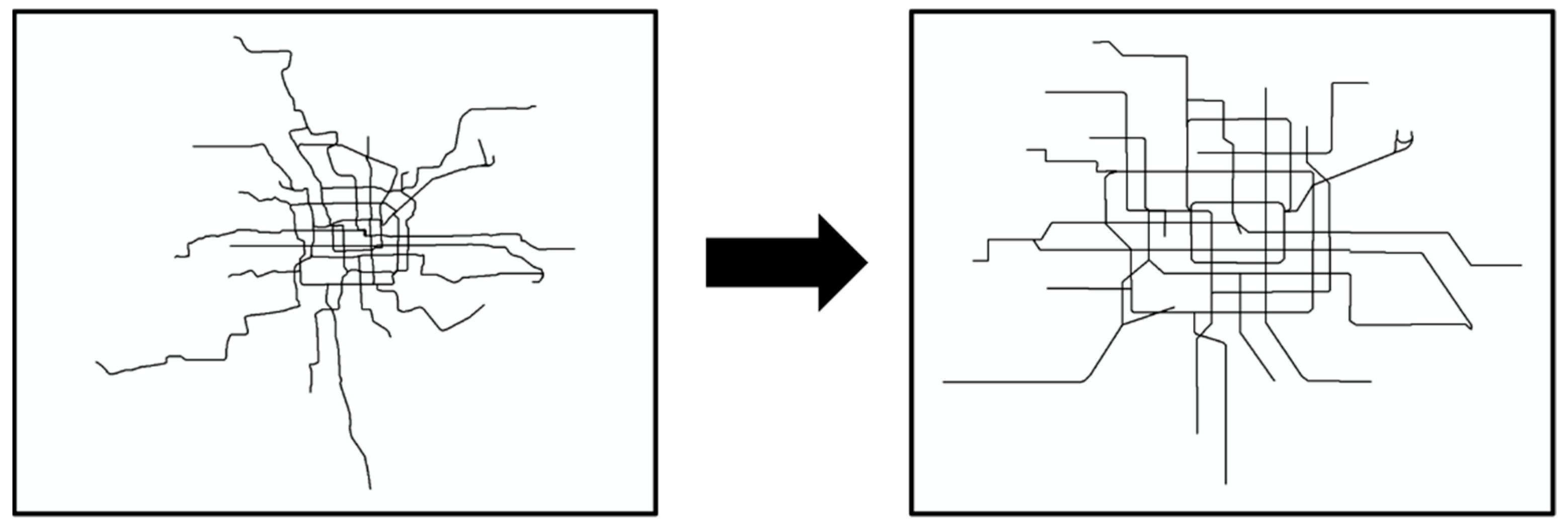

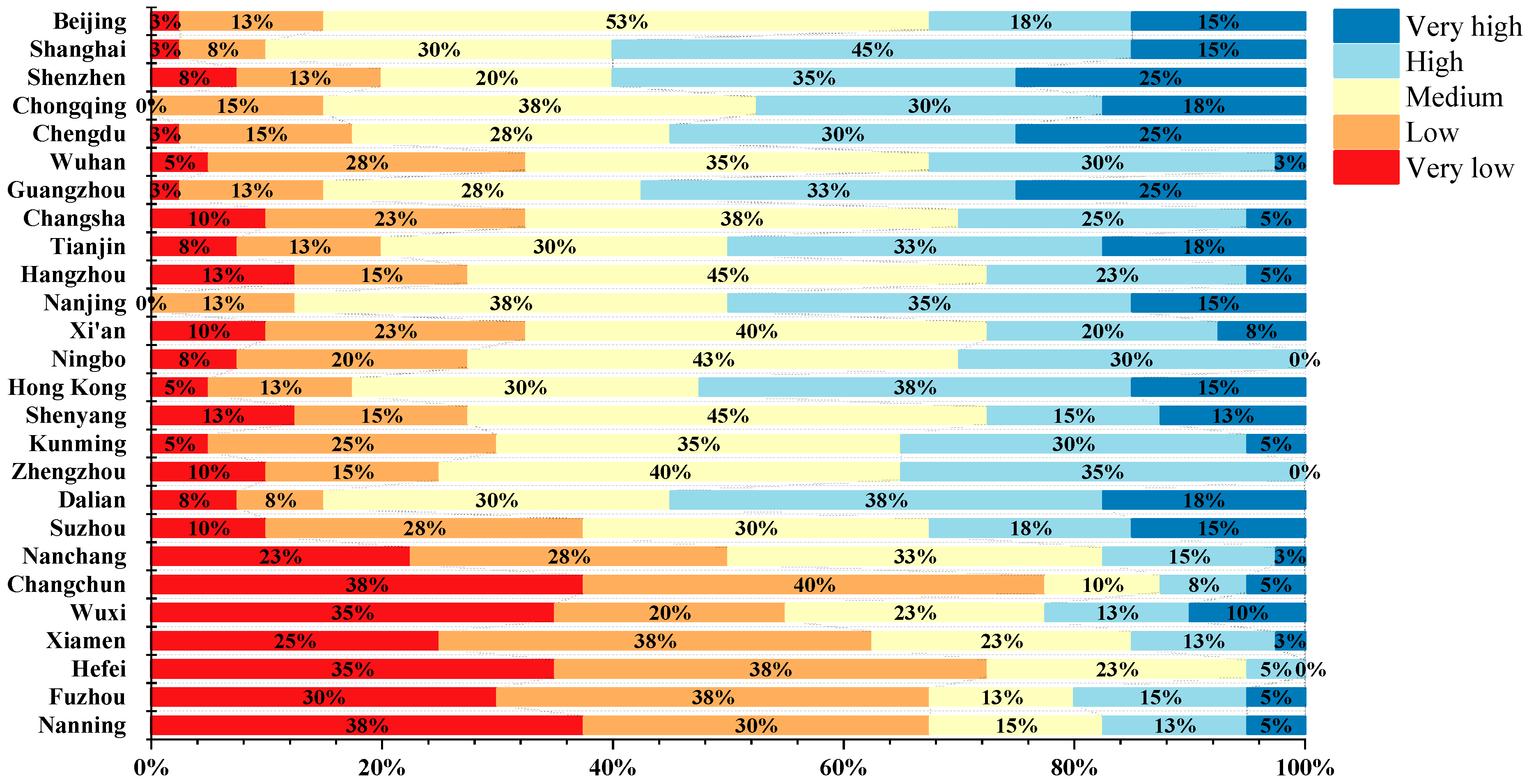
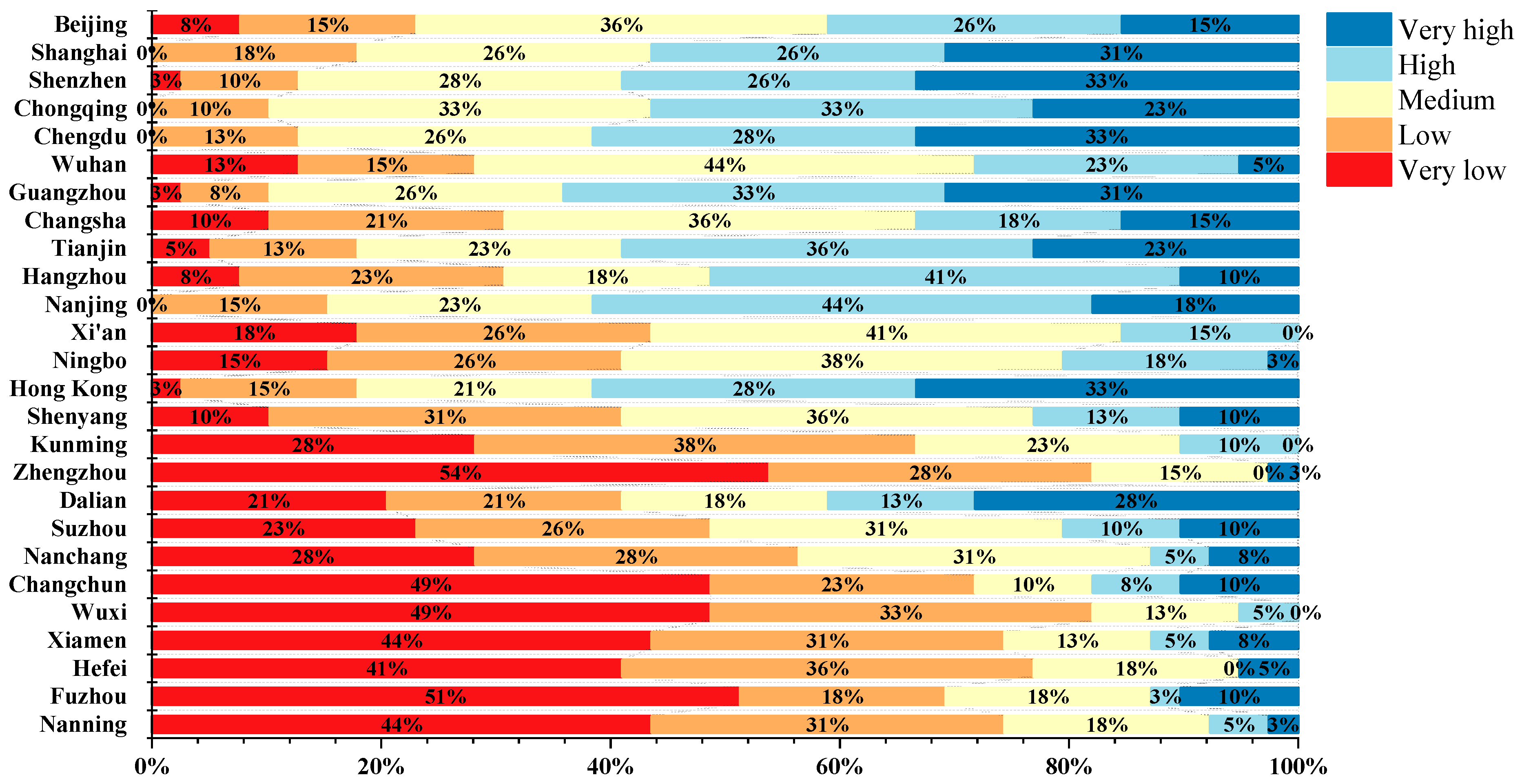


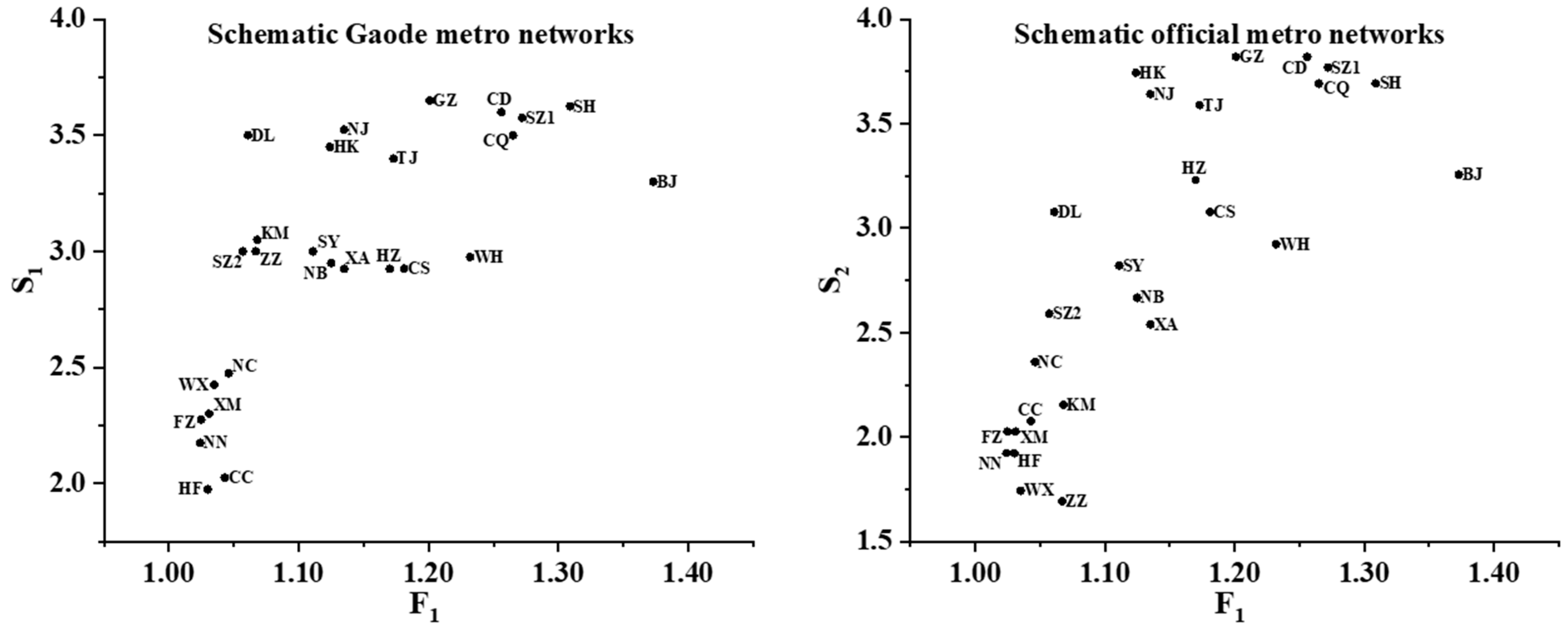

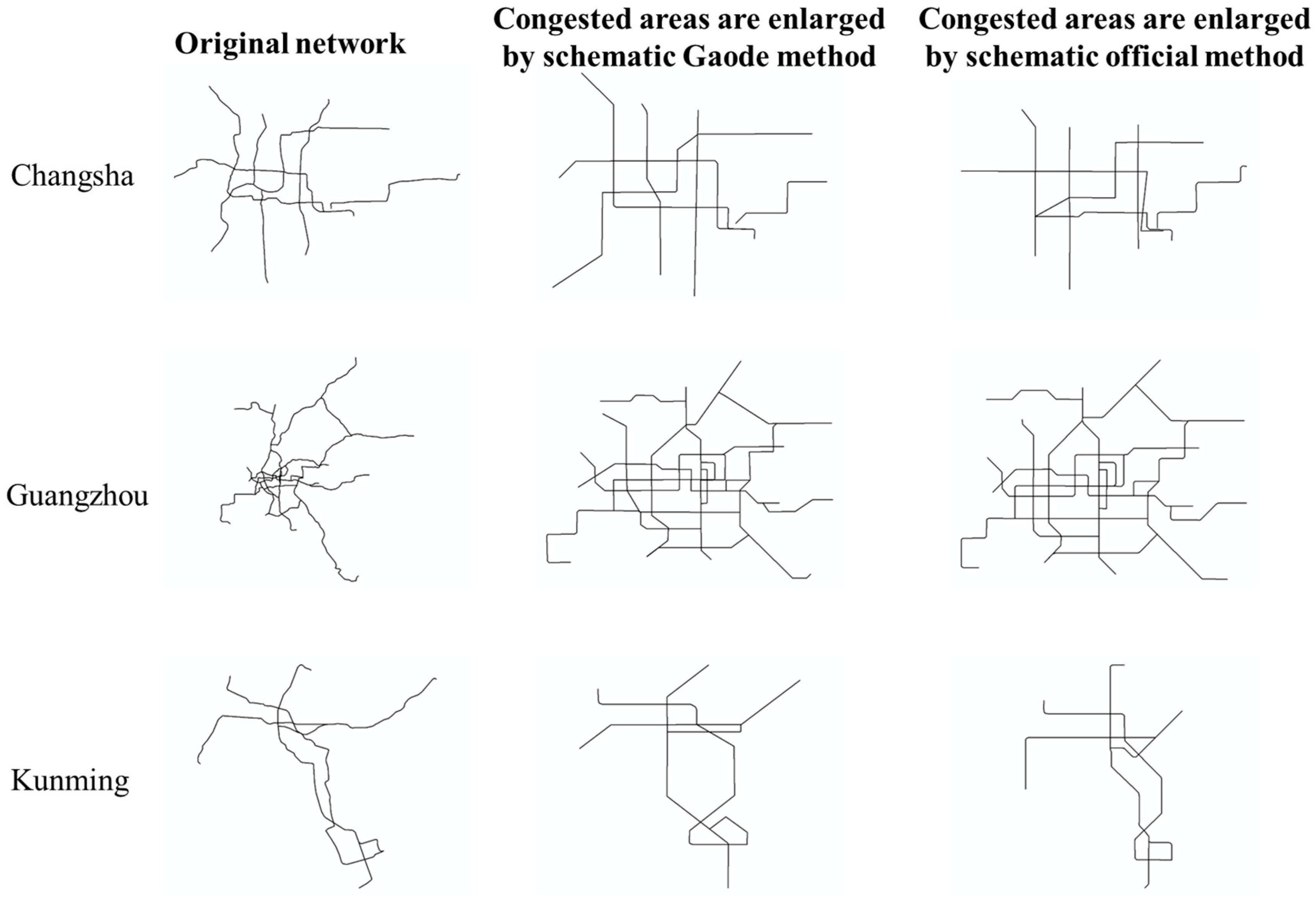
| City | ||||||||
|---|---|---|---|---|---|---|---|---|
| Beijing | 1.373 | 0.999 | 1.187 | 0.998 | 1.210 | 0.998 | 0.186 | 0.163 |
| Shanghai | 1.309 | 0.998 | 1.162 | 0.998 | 1.157 | 0.998 | 0.147 | 0.152 |
| Shenzhen | 1.272 | 0.998 | 1.257 | 0.998 | 1.195 | 0.998 | 0.015 | 0.077 |
| Chongqing | 1.265 | 0.998 | 1.097 | 0.999 | 1.095 | 0.999 | 0.168 | 0.170 |
| Chengdu | 1.256 | 0.999 | 1.107 | 0.998 | 1.135 | 0.999 | 0.149 | 0.121 |
| Wuhan | 1.232 | 0.999 | 1.170 | 0.999 | 1.161 | 0.999 | 0.062 | 0.071 |
| Guangzhou | 1.201 | 0.998 | 1.148 | 0.998 | 1.120 | 0.998 | 0.053 | 0.081 |
| Changsha | 1.181 | 0.999 | 1.041 | 0.999 | 1.049 | 0.999 | 0.140 | 0.132 |
| Tianjin | 1.173 | 0.999 | 1.077 | 0.999 | 1.058 | 0.999 | 0.096 | 0.115 |
| Hangzhou | 1.170 | 0.998 | 1.097 | 0.999 | 1.107 | 0.999 | 0.073 | 0.063 |
| Nanjing | 1.135 | 0.999 | 1.088 | 0.998 | 1.092 | 0.998 | 0.047 | 0.043 |
| Xi’an | 1.135 | 0.998 | 1.062 | 0.999 | 1.051 | 0.999 | 0.073 | 0.084 |
| Ningbo | 1.125 | 0.999 | 1.033 | 0.999 | 1.019 | 0.999 | 0.092 | 0.106 |
| Hong Kong | 1.124 | 0.999 | 1.123 | 0.999 | 1.109 | 0.999 | 0.001 | 0.015 |
| Shenyang | 1.111 | 0.999 | 1.056 | 0.999 | 1.036 | 0.999 | 0.055 | 0.075 |
| Kunming | 1.068 | 0.999 | 1.046 | 0.999 | 1.043 | 0.999 | 0.022 | 0.025 |
| Zhengzhou | 1.067 | 0.999 | 1.060 | 0.999 | 1.055 | 0.999 | 0.007 | 0.012 |
| Dalian | 1.061 | 0.999 | 1.003 | 0.999 | 1.002 | 0.999 | 0.058 | 0.059 |
| Suzhou | 1.057 | 0.999 | 1.030 | 0.999 | 1.011 | 0.999 | 0.027 | 0.046 |
| Nanchang | 1.046 | 0.999 | 1.032 | 0.999 | 1.022 | 0.998 | 0.014 | 0.024 |
| Changchun | 1.043 | 0.999 | 1.023 | 0.999 | 1.034 | 0.999 | 0.020 | 0.009 |
| Wuxi | 1.035 | 0.999 | 1.016 | 0.999 | 1.011 | 0.999 | 0.019 | 0.024 |
| Xiamen | 1.031 | 0.999 | 1.001 | 0.999 | 1.002 | 0.999 | 0.030 | 0.029 |
| Hefei | 1.030 | 0.999 | 1.021 | 0.999 | 1.022 | 0.999 | 0.009 | 0.008 |
| Fuzhou | 1.025 | 0.999 | 1.007 | 0.999 | 1.001 | 0.999 | 0.018 | 0.024 |
| Nanning | 1.024 | 0.999 | 1.018 | 0.999 | 1.024 | 0.999 | 0.006 | 0.000 |
| Paired Observations | ||
|---|---|---|
| Spearman correlation coefficient | 0.715 | 0.853 |
| 95% Confidence Interval | (0.690, 0.739) | (0.844, 0.861) |
| 90% Confidence Interval | (0.694, 0.736) | (0.846, 0.860) |
| 85% Confidence Interval | (0.696, 0.733) | (0.846, 0.859) |
| 80% Confidence Interval | (0.698, 0.731) | (0.847, 0.858) |
| 75% Confidence Interval | (0.700, 0.729) | (0.847, 0.858) |
| 70% Confidence Interval | (0.702, 0.728) | (0.848, 0.857) |
| 65% Confidence Interval | (0.703, 0.726) | (0.848, 0.857) |
| 60% Confidence Interval | (0.704, 0.725) | (0.849, 0.857) |
| 55% Confidence Interval | (0.705, 0.724) | (0.849, 0.856) |
| 50% Confidence Interval | (0.707, 0.724) | (0.850, 0.856) |
| 45% Confidence Interval | (0.708, 0.723) | (0.850, 0.855) |
| 40% Confidence Interval | (0.709, 0.722) | (0.850, 0.855) |
| 35% Confidence Interval | (0.709, 0.721) | (0.851, 0.855) |
| 30% Confidence Interval | (0.710, 0.720) | (0.851, 0.855) |
| 25% Confidence Interval | (0.711, 0.719) | (0.851, 0.854) |
| 20% Confidence Interval | (0.712, 0.719) | (0.851, 0.854) |
| 15% Confidence Interval | (0.713, 0.718) | (0.852, 0.854) |
| 10% Confidence Interval | (0.714, 0.717) | (0.852, 0.853) |
| 5% Confidence Interval | (0.714, 0.716) | (0.852, 0.853) |
| Aspect | Score (Total 5 Scores) | ||||
|---|---|---|---|---|---|
| 1 | 2 | 3 | 4 | 5 | |
| Complexity change comparing the original schematic metro networks | Very low | Low | Medium | High | Very high |
| Method | Valid Records | Gender (Male/Female) | Age Range | Cartography Background | Other Backgrounds |
|---|---|---|---|---|---|
| Gaode | 40 | 22/18 | 18–60 | 33 | 7 |
| Official | 39 | 25/14 | 18–50 | 35 | 4 |
| City | Original Network | Schematic Gaode Network | Schematic Official Network | ||
|---|---|---|---|---|---|
| Beijing | 1.373 | 3.300 | 0.186 | 3.256 | 0.163 |
| Shanghai | 1.309 | 3.625 | 0.147 | 3.692 | 0.152 |
| Shenzhen | 1.272 | 3.575 | 0.015 | 3.769 | 0.077 |
| Chongqing | 1.265 | 3.500 | 0.168 | 3.692 | 0.170 |
| Chengdu | 1.256 | 3.600 | 0.149 | 3.821 | 0.121 |
| Wuhan | 1.232 | 2.975 | 0.062 | 2.923 | 0.071 |
| Guangzhou | 1.201 | 3.650 | 0.053 | 3.821 | 0.081 |
| Changsha | 1.181 | 2.925 | 0.140 | 3.077 | 0.132 |
| Tianjin | 1.173 | 3.400 | 0.096 | 3.590 | 0.115 |
| Hangzhou | 1.170 | 2.925 | 0.073 | 3.231 | 0.063 |
| Nanjing | 1.135 | 3.525 | 0.047 | 3.641 | 0.043 |
| Xi’an | 1.135 | 2.925 | 0.073 | 2.538 | 0.084 |
| Ningbo | 1.125 | 2.950 | 0.092 | 2.667 | 0.106 |
| Hong Kong | 1.124 | 3.450 | 0.001 | 3.744 | 0.015 |
| Shenyang | 1.111 | 3.000 | 0.055 | 2.821 | 0.075 |
| Kunming | 1.068 | 3.050 | 0.022 | 2.154 | 0.025 |
| Zhengzhou | 1.067 | 3.000 | 0.007 | 1.692 | 0.012 |
| Dalian | 1.061 | 3.500 | 0.058 | 3.077 | 0.059 |
| Suzhou | 1.057 | 3.000 | 0.027 | 2.590 | 0.046 |
| Nanchang | 1.046 | 2.475 | 0.014 | 2.359 | 0.024 |
| Changchun | 1.043 | 2.025 | 0.020 | 2.077 | 0.009 |
| Wuxi | 1.035 | 2.425 | 0.019 | 1.744 | 0.024 |
| Xiamen | 1.031 | 2.300 | 0.030 | 2.026 | 0.029 |
| Hefei | 1.030 | 1.975 | 0.009 | 1.923 | 0.008 |
| Fuzhou | 1.025 | 2.275 | 0.018 | 2.026 | 0.024 |
| Nanning | 1.024 | 2.175 | 0.006 | 1.923 | 0.000 |
| Paired Observations | ||
|---|---|---|
| Spearman correlation coefficient | 0.411 | 0.687 |
| 95% Confidence Interval | (0.377, 0.444) | (0.660, 0.712) |
| 90% Confidence Interval | (0.382, 0.439) | (0.664, 0.707) |
| 85% Confidence Interval | (0.386, 0.436) | (0.667, 0.706) |
| 80% Confidence Interval | (0.389, 0.434) | (0.669, 0.704) |
| 75% Confidence Interval | (0.391, 0.432) | (0.671, 0.702) |
| 70% Confidence Interval | (0.393, 0.429) | (0.673, 0.700) |
| 65% Confidence Interval | (0.395, 0.427) | (0.674, 0.698) |
| 60% Confidence Interval | (0.396, 0.426) | (0.676, 0.697) |
| 55% Confidence Interval | (0.398, 0.424) | (0.677, 0.696) |
| 50% Confidence Interval | (0.399, 0.423) | (0.678, 0.695) |
| 45% Confidence Interval | (0.400, 0.422) | (0.679, 0.694) |
| 40% Confidence Interval | (0.402, 0.421) | (0.680, 0.694) |
| 35% Confidence Interval | (0.403, 0.420) | (0.681, 0.693) |
| 30% Confidence Interval | (0.405, 0.418) | (0.682, 0.692) |
| 25% Confidence Interval | (0.406, 0.417) | (0.683, 0.691) |
| 20% Confidence Interval | (0.407, 0.416) | (0.684, 0.690) |
| 15% Confidence Interval | (0.408, 0.415) | (0.685, 0.689) |
| 10% Confidence Interval | (0.409, 0.414) | (0.685, 0.689) |
| 5% Confidence Interval | (0.411, 0.413) | (0.686, 0.688) |
| Paired Observations | ||
|---|---|---|
| Spearman correlation coefficient | 0.745 | 0.824 |
| 95% Confidence Interval | (0.723, 0.764) | (0.812, 0.835) |
| 90% Confidence Interval | (0.728, 0.762) | (0.814, 0.832) |
| 85% Confidence Interval | (0.730, 0.759) | (0.816, 0.831) |
| 80% Confidence Interval | (0.732, 0.758) | (0.816, 0.830) |
| 75% Confidence Interval | (0.733, 0.756) | (0.817, 0.829) |
| 70% Confidence Interval | (0.734, 0.755) | (0.818, 0.829) |
| 65% Confidence Interval | (0.735, 0.754) | (0.818, 0.828) |
| 60% Confidence Interval | (0.736, 0.753) | (0.819, 0.828) |
| 55% Confidence Interval | (0.737, 0.752) | (0.819, 0.828) |
| 50% Confidence Interval | (0.738, 0.752) | (0.820, 0.827) |
| 45% Confidence Interval | (0.738, 0.751) | (0.820, 0.827) |
| 40% Confidence Interval | (0.739, 0.751) | (0.821, 0.827) |
| 35% Confidence Interval | (0.740, 0.750) | (0.821, 0.826) |
| 30% Confidence Interval | (0.741, 0.749) | (0.821, 0.826) |
| 25% Confidence Interval | (0.741, 0.748) | (0.822, 0.825) |
| 20% Confidence Interval | (0.742, 0.747) | (0.822, 0.825) |
| 15% Confidence Interval | (0.743, 0.747) | (0.823, 0.825) |
| 10% Confidence Interval | (0.743, 0.746) | (0.823, 0.824) |
| 5% Confidence Interval | (0.744, 0.745) | (0.823, 0.824) |
| City | Original Network | Gaode Schematic Network | Official Schematic Network | ||||||
|---|---|---|---|---|---|---|---|---|---|
| Beijing | 0.0151 | 3.1781 | 6.0530 | 0.0203 | 3.6445 | 5.6173 | 0.0212 | 3.7852 | 5.8693 |
| Shanghai | 0.0144 | 3.1051 | 5.6247 | 0.0241 | 4.1072 | 6.2593 | 0.0246 | 4.1209 | 6.3228 |
| Shenzhen | 0.0161 | 3.3284 | 5.5108 | 0.0187 | 3.4417 | 5.8338 | 0.0213 | 3.7005 | 5.4791 |
| Chongqing | 0.0113 | 2.8493 | 5.6135 | 0.0157 | 3.1417 | 5.3954 | 0.0186 | 3.5835 | 5.2646 |
| Chengdu | 0.0140 | 3.0658 | 5.4578 | 0.0213 | 3.6486 | 5.5535 | 0.0276 | 4.3587 | 5.2923 |
| Wuhan | 0.0118 | 2.8689 | 5.3100 | 0.0116 | 2.6224 | 5.1009 | 0.0148 | 2.8890 | 4.9391 |
| Guangzhou | 0.0095 | 2.5655 | 5.2333 | 0.0175 | 3.3668 | 4.9164 | 0.0186 | 3.4706 | 4.8253 |
| Changsha | 0.0094 | 2.5872 | 4.6973 | 0.0107 | 2.5834 | 4.1849 | 0.0091 | 2.3707 | 4.3177 |
| Tianjin | 0.0074 | 2.2731 | 5.0508 | 0.0143 | 2.9904 | 4.3920 | 0.0141 | 2.9322 | 4.3624 |
| Hangzhou | 0.0075 | 2.3324 | 4.9070 | 0.0092 | 2.4010 | 4.8283 | 0.0120 | 2.7170 | 4.6717 |
| Nanjing | 0.0054 | 1.9841 | 4.8054 | 0.0097 | 2.3794 | 4.4608 | 0.0109 | 2.5638 | 4.4574 |
| Xi’an | 0.0109 | 2.7765 | 4.4517 | 0.0093 | 2.4392 | 4.2356 | 0.0114 | 2.7378 | 4.2618 |
| Ningbo | 0.0078 | 2.3936 | 4.3218 | 0.0098 | 2.4261 | 3.9233 | 0.0087 | 2.2531 | 3.8586 |
| Hong Kong | 0.0103 | 2.7048 | 4.6339 | 0.0163 | 3.1324 | 4.6263 | 0.0168 | 3.1359 | 4.5962 |
| Shenyang | 0.0083 | 2.4020 | 4.3281 | 0.0090 | 2.4133 | 4.2148 | 0.0070 | 2.0984 | 3.9724 |
| Kunming | 0.0074 | 2.3169 | 4.6283 | 0.0082 | 2.1955 | 4.2482 | 0.0069 | 2.0858 | 4.3488 |
| Zhengzhou | 0.0096 | 2.5677 | 4.9129 | 0.0108 | 2.5976 | 4.6702 | 0.0094 | 2.4503 | 4.7618 |
| Dalian | 0.0041 | 1.8817 | 4.4539 | 0.0054 | 1.9474 | 3.8893 | 0.0058 | 1.9943 | 3.7701 |
| Suzhou | 0.0086 | 2.5058 | 4.6823 | 0.0086 | 2.3585 | 4.3295 | 0.0082 | 2.2785 | 4.3417 |
| Nanchang | 0.0065 | 2.1404 | 4.3399 | 0.0067 | 2.0943 | 4.0181 | 0.0074 | 2.1687 | 4.0834 |
| Changchun | 0.0075 | 2.2475 | 4.1624 | 0.0077 | 2.1875 | 3.9589 | 0.0069 | 2.0725 | 3.9943 |
| Wuxi | 0.0064 | 2.1544 | 4.1673 | 0.0066 | 2.1062 | 3.9428 | 0.0066 | 2.0811 | 3.9722 |
| Xiamen | 0.0060 | 2.1143 | 3.9569 | 0.0063 | 1.9891 | 3.6094 | 0.0053 | 1.8717 | 3.5871 |
| Hefei | 0.0079 | 2.3279 | 4.1853 | 0.0083 | 2.2814 | 3.8880 | 0.0078 | 2.2020 | 3.9378 |
| Fuzhou | 0.0049 | 1.9234 | 3.7903 | 0.0048 | 1.8334 | 3.5991 | 0.0053 | 1.9127 | 3.7133 |
| Nanning | 0.0077 | 2.3531 | 4.2286 | 0.0079 | 2.2158 | 3.8978 | 0.0083 | 2.2363 | 3.8855 |
Disclaimer/Publisher’s Note: The statements, opinions and data contained in all publications are solely those of the individual author(s) and contributor(s) and not of MDPI and/or the editor(s). MDPI and/or the editor(s) disclaim responsibility for any injury to people or property resulting from any ideas, methods, instructions or products referred to in the content. |
© 2024 by the authors. Licensee MDPI, Basel, Switzerland. This article is an open access article distributed under the terms and conditions of the Creative Commons Attribution (CC BY) license (https://creativecommons.org/licenses/by/4.0/).
Share and Cite
Lan, T.; Wu, Z.; Sun, C.; Cheng, D.; Shi, X.; Zeng, G.; Zhang, H.; Peng, Q. Assessing the Suitability of Fractal Dimension for Measuring Graphic Complexity Change in Schematic Metro Networks. ISPRS Int. J. Geo-Inf. 2024, 13, 38. https://doi.org/10.3390/ijgi13020038
Lan T, Wu Z, Sun C, Cheng D, Shi X, Zeng G, Zhang H, Peng Q. Assessing the Suitability of Fractal Dimension for Measuring Graphic Complexity Change in Schematic Metro Networks. ISPRS International Journal of Geo-Information. 2024; 13(2):38. https://doi.org/10.3390/ijgi13020038
Chicago/Turabian StyleLan, Tian, Zhiwei Wu, Chenzhen Sun, Donglin Cheng, Xing Shi, Guangjun Zeng, Hong Zhang, and Qian Peng. 2024. "Assessing the Suitability of Fractal Dimension for Measuring Graphic Complexity Change in Schematic Metro Networks" ISPRS International Journal of Geo-Information 13, no. 2: 38. https://doi.org/10.3390/ijgi13020038
APA StyleLan, T., Wu, Z., Sun, C., Cheng, D., Shi, X., Zeng, G., Zhang, H., & Peng, Q. (2024). Assessing the Suitability of Fractal Dimension for Measuring Graphic Complexity Change in Schematic Metro Networks. ISPRS International Journal of Geo-Information, 13(2), 38. https://doi.org/10.3390/ijgi13020038







